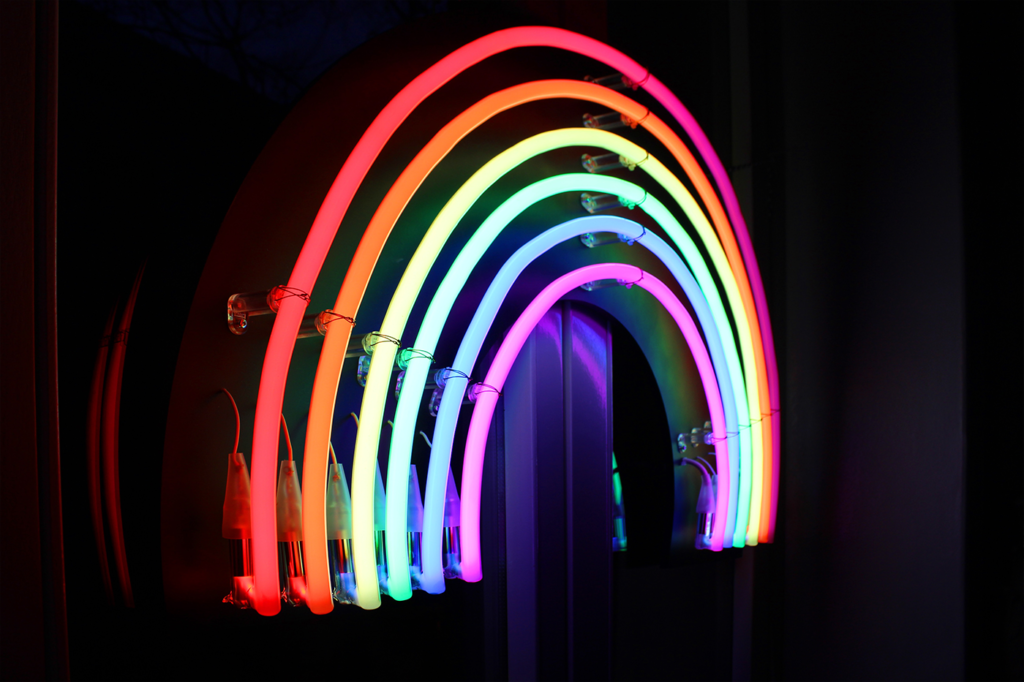The six-barred LGBT “rainbow” symbol has become part of our everyday landscape. Since the late 1970s, it has been ubiquitous at LGBT parades and demonstrations. In more recent years, it has become a feature in the commercial field of corporate and brand marketing, particularly during the month of June. More controversially, the symbol is now commonly encountered in the sports arena. All of this prompts questions as to the nature and purpose of this symbol.
A symbol is a sign that represents something else by association, resemblance, or convention. Often, a material object is used to represent something invisible and abstract. To aid recognition of their products, companies develop brand symbols, usually in the form of logos. They use distinctive shapes and colors to differentiate these brand symbols, in some cases with such success that they can even omit the brand name and still be immediately identified.
The rainbow symbol has likewise become something of a cultural icon. Its adoption as an emblem for the LGBT community dates from 1978, when San Francisco–based artist Gilbert Baker had the original eight-color version produced for Gay Freedom Day. According to Baker, “For the past almost 40 years, the rainbow flag has stood as a politically powerful, meaningful, and also aesthetically effective symbol.” Like the Nike swoosh or the Apple logo, the rainbow symbol clearly points to something beyond its literal depiction—but to what, exactly?
Baker has said he wanted to convey the idea of diversity and inclusion. To this end, he appropriated and adapted an existing symbol and refashioned its meaning. Baker’s design is not actually a rainbow but a multicolored flag based on the colors of the rainbow. “A flag fit us as a symbol. . . . Flags are about proclaiming power,” he asserts. Yet the sheer force of the political power represented by Baker’s flag and the ideology it symbolizes must have surprised even him. It has led to changes in government policies and shifts in public attitudes. New legislation has been introduced and court decisions issued amending the legal definition of marriage, forcing adoption agencies to close, mandating gender-neutral bathrooms, ushering in new employment practices, altering school curricula, and causing many other profound societal changes.
Start your day with Public Discourse
Sign up and get our daily essays sent straight to your inbox.Mixing Marketing with Politics
The rainbow flag is the most visible and tangible representation of the LGBT lobby. Given its political nature, the incorporation of this symbol in a commercial context—on packaging, logos, advertising, websites, social media, and shop windows—can come across as forced and artificial. This is most evident during the month of June, officially declared (by then-president Obama) “Pride Month,” when there is a tsunami of rainbow-adorned merchandise. At times, the products themselves seem incidental to the ideological message.
In sports, the situation is even more sensitive. In many team sports, for example, the jersey is sacrosanct. Fans identify with it. Players revere it. It is worn by both with pride. Sponsors’ brands, often just one and in the form of a logo, are accepted as a necessary part of commercial survival. They share precious space on the jersey alongside the club crest and the shirt manufacturer logo in a kind of unholy alliance. So: Manchester United crest, Adidas logo, and Chevrolet logo; or Juventus crest, Adidas logo, JEEP logo. Anything extraneous to this arrangement—other logos, particularly a political badge or symbol—would likely be deemed intrusive by the committed supporter. Genuine supporters would probably not take kindly to having the hallowed jersey turned into a propaganda vehicle for some ideological cause or identity.
Moreover, players themselves are increasingly coming under pressure to put aside their own reservations about sexual politics—or face the consequences. Two years ago, the talented US women’s soccer player Jaelene Hinkle declined a call-up to the US Women’s National Team because she did not want to be forced to wear the team’s new LBGT pride jersey. Although she initially preferred to keep her reasons to herself, she eventually admitted that her decision was informed by her religious conscience. That was the end of her career with the USWNT.
Packaged goods and service companies have been falling over themselves to hastily retro-fit LGBT language into their mission statements and emblazon their products and messaging with the rainbow flag. Negative reactions to this have come from both ends of the ideological spectrum. At one end is growing consumer fatigue, disgruntlement, and backlash—as companies like Target and Gillette have experienced in recent months. At the other end is a different type of pushback and criticism, embodied in the neologism “rainbow-washing.” The term refers to the act of incorporating the rainbow symbol and imagery in order to signal support for the LGBT community and earn praise with a minimum of effort or practical result.
British chain Marks and Spencer (M&S) provides a recent example. In May, it launched a new “LGBT” sandwich, a play on the classic BLT that was filled with lettuce, guacamole, bacon, and tomato (reflecting the LGBT acronym), complete with rainbow-colored packaging. The promotion was not only ridiculed by those weary of the onslaught of rainbow-adorned merchandise; it also drew criticism from LGBT consumers who complained of opportunism and profiteering. M&S caused similar controversy with the launch of its “Rainbow Sandwich” in July 2018.
In other words, companies are being called out for bad faith by the very people with whom they are seeking to ingratiate themselves through their marketing. LGBT activists are demanding that companies enact LGBT ideology in its fullness. That means having gender neutral bathrooms and changing rooms in their stores and offices, LGBT safeguarding policies and complaints procedures, the “correct” use of pronouns, HIV+ treatment assistance and support, and on and on. The message is clear: “Only if you’re doing all of that, and everything else you can do to support the LGBT+ community, do you have the right to associate yourself with our movement.” That rainbow symbol stamped on a pair of sneakers or bottle of liquor is only the tip of a very deep and convoluted iceberg.
Anti-Branding
From a marketing standpoint, this criticism from all sides is particularly revealing. The problem is not simply that these companies are “not doing LGBT properly.” It is, more to the point, that they are not doing brand marketing properly. When you hitch your brand to a cause or movement that nearly every other brand is co-opting, you are not differentiating but rather genericizing your brand. That’s anti-branding. When the cause or movement you choose has political overtones, you end up alienating, dividing, and disappointing your customers.
From a demographic, psychographic, and socioeconomic point of view, a brand’s customer base is rarely uniform. Particularly in the case of mainstream brands, it is diverse, consisting of people of different racial, ethnic, and religious backgrounds; of different political, philosophical, and ideological persuasions; and of different age, sex, and marital status. A small percentage of the customer base (perhaps 3–4 percent) may identify as LGBT. Yet they are all equal as customers, paying the same money for the same product. For companies to regale this small percentage of LGBT customers with preferential treatment and tailored promotion in the name of inclusivity is nonsensical and even discriminatory. The somewhat puzzling stock phrase used to explain donations to LGBT organizations on the back of these promotions is, “giving back to the LGBT community.” Which elicits the retort, what of the non-LGBT community—who happen to be around 96 percent of a brand’s users? Or people with disabilities? Or, indeed, those for whom, say, the environment, gun control, human trafficking, or freedom of conscience are issues of more pressing concern?
When Baker designed his flag, the LGBT community was unfairly marginalized. The flag was about resistance to that marginalization and was an attempt to gain respect. Forty years later, the political programs and reinvented social order that the rainbow symbol represents are far more complex and extreme. The aggressive radicalization of the LGBT movement’s ideology and its intolerance of diverse opinion are creating division and causing reappraisal by some—both within and outside its ranks—and downright misery for others. The latter include the many well-meaning business owners whose personal and religious convictions prevent them from being party to certain activities or transactions. For that, they have been victimized, vilified, and made to pay a heavy price.
Not all people are comfortable with the LGBT agenda. In a recent, high-profile example from the United Kingdom, a school in Birmingham was forced to stop lessons in its LGBT-friendly curriculum after Christian and Muslim parents discovered their children, some as young as four, were being given classes on same-sex relationships. Hundreds of pupils were withdrawn from the school in protest at what the parents saw as indoctrination of their children. Concern and protest about the curriculum quickly spread to other schools and cities.
Yet by incorporating the rainbow flag in its merchandising a company is explicitly affirming today’s radical LGBT ideology. That includes restricting others’ freedom of conscience, equating same-sex parenting with mother-father parenting, advocating commercial surrogacy, promoting sex-change surgery, demanding punishment for pronoun transgressions, and so forth. Moreover, companies are taking for granted that customers embrace this thinking too. That boils down to taking customers for granted. Don’t ordinary people have a right to keep certain areas of their lives free from propaganda and polemic? Don’t they have the right not to be browbeaten with activism, lobbying, and cause-marketing when they just want to buy a soda or watch a game of soccer?
LGBT matters are complex, and we need to keep having conversations about them—in the right forum. For 99 percent of brands, that forum should not be in their product or its packaging. Marketers should realize that chasing the “pink dollar” via gimmicky promotion actually does them no favors in the long run. Indeed, marketers would do well to remember the oft-repeated adage: it’s the consumer who owns the brand. Not the LGBT movement.














